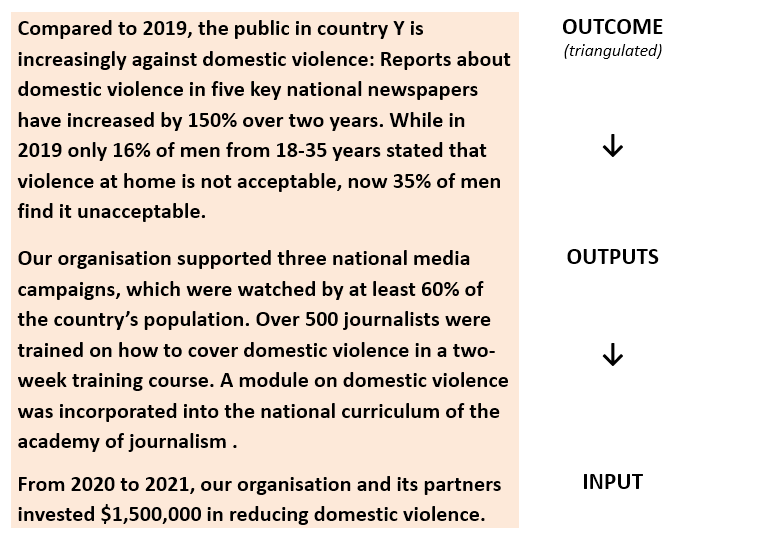Do you hate report writing? Fed up with writing long, detailed reports that nobody seems to read?
But the truth is: report writing IS important. And it can be exciting :-). It can showcase what we have achieved. It is important to show those that have provided the money – taxpayers, communities, donors, charities, etc. – that we used it effectively. Further, report writing is crucial to mobilise more money. And: it helps those making decisions to improve what we do.
Our tips for good reporting
Good reporting isn’t that hard. My five tips for writing stellar reports are: 1. start with what is important, 2. use simple language, 3. use change language, 4. back it up with evidence, and 5. visualise data.

1. Start with what is important
Given the usual short attention span of most people, start with the most important things. I repeat because that’s really important: Start with what really counts in a report. And in Results Based Management, what really counts is results. So: start with outcomes, outputs and – if feasible – impact.
In the report, develop a storyline that describes changes on the outcome level. Follow up with a description of the outputs delivered to make these changes happen. If useful, include a limited number of key activities carried out to deliver the outputs. Finally, include the funds used to carry out these activities (=inputs). Here is a simplified example of a storyline from outcomes to outputs and inputs.

2. Use simple language in reports
When we write reports, we want to be understood by the reader. That is why we should make it as easy as possible for the reader to understand what we try to communicate (without oversimplifications).
3. Use change language in reports
This is very, very important in report writing. It looks like a small thing, but the way we formulate the results achieved has a tremendous effect on the quality of the report. So instead of saying “Our organisation supported the peer education of 20.000 unemployed women and men over 50 years”, say “20.000 unemployed women and men now know how to start a small business”. Check out our blog on How to use change language.
4. Back reports up with evidence
In our reports, any claim of success or progress, attribution or contribution must be backed up by evidence. It’s obvious, isn’t it? What is ‘evidence’? Evidence is anything presented to objectively support a claim. It is not the untested views of individuals or groups, sometimes inspired by ideological standpoints, prejudices, or speculative conjecture.
5. Visualise data
If you are like me (and many are), a report using only words and numbers is not easy to read at all.
The inclusion of simple visuals is an effective way to write reports and to communicate. For example, data can include charts, maps, graphs, time series, interactive visualisation, infographics, matrices, hierarchies, pictures, micro-content for social media, videos, comics, etc.
Data visualisation is a broad field. Here are few pointers to some outstanding resources on data visualisation:
- The Data Visualization Checklist by the wonderful Stephanie Evergreen can help you check if your visualization is good. Check it out at http://stephanieevergreen.com/dataviz-checklist/.
- When trying to decide which chart of graph to use, you can look at this blog at https://blog.hubspot.com/marketing/types-of-graphs-for-data-visualization.
- For an excellent and graphic overview of different options to visualise data, visit http://betterevaluation.org/plan/describe/visualise_data.

What to learn more about how to plan, monitor and report on results? Check out our detailed video course on Practical Results Based Management on Udemy.